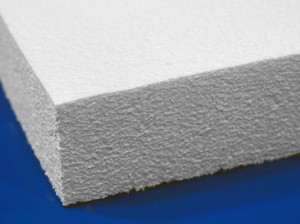As winter drags on, many people see each snowflake that falls as another penny coming out of their pockets on their next utility bill. The harder your heating and cooling systems have to work to reach and maintain temperatures, the more money it costs to power them. While one source of unnecessary cost may be the efficiency of your heating and cooling system, an aspect of temperature control that often goes overlooked is home insulation. Most materials used in construction, like wood, glass, brick, and concrete, are poor thermal insulators with very low R-Values, a measure of thermal resistance.
To ensure that homes and buildings retain the warmth or coolness desired, and resist the heat or cold present outside, insulation is added to keep homes more comfortable and efficient. Closed-cell foam materials are often used as insulation, including polystyrene (EPS) and polyethylene, both of which Foam Factory is proud to offer.

One of the most important aspects of thermal insulation that must be understood before deciding to add or replace insulation is R-Value. This is a measure of thermal resistance, which can also be interpreted as insulating capability. These values are typically gathered by a formula measuring temperature change after testing a material sample of a standardized size. The greater a material’s R-Value, the better its insulating capability. Additionally, the greater a material’s thickness, the greater its R-Value, given that there is more material heat or cold must transfer through.
Foam Factory’s polyethylene and polystyrene sheet foam both have strong R-Values, providing thermal resistance in whatever application they are used in. Foam insulation can be used in many ways throughout the house, including walls, ceilings, and around pipes, ducts and other home systems. Foam Factory offers styles of these foam materials for use in any of these applications.
The most common place for foam insulation is in walls and ceilings, particularly attics. Untreated, these areas can allow heat and air conditioning to quickly be lost, so keeping them insulated is very important to a comfortable home. Polystyrene foam sheets are one excellent material for lining walls and ceilings. Adding thermal insulation materials can also help quiet a home. While not its main purpose, by adding extra mass to the building’s construction, additional sound dampening is added as well.
Perhaps the most important quality of polystyrene is that its insulating capacity does not diminish over time. EPS is composed of structural material and normal air, as opposed to gasses. Extruded polystyrene (XPS) uses gases in its formulation, and as they slowly dissipate, the material’s insulating R-Value decreases. EPS maintains R-Value throughout the life of the product. EPS offers a benefit over spray foam as well, simply by how much easier it is to work with for do-it-yourself projects. It doesn’t require special safety suits for application, there isn’t the potential for accidental messes, and it can also be applied at any temperature. Spray foam application in low temperatures can affect the curing process, and ultimately, its performance. Rigid EPS insulation is also much more cost-effective and many people choose to install it on their own, saving even more money.

Another thermal insulation material that can easily produce value in energy savings is polyethylene. Often used in pipe wraps, polyethylene can help reduce the transfer of heat or coolness away from water through piping. Water staying at temperature means conditioning systems use less energy, which equates to a lower bill. Polyethylene is available in densities from 1.7LB all the way up to 9LB, as well as an Anti-Static formulation. Just like the polystyrene, polyethylene can be ordered in custom-cut sizes for special pipe insulation projects as well.
While most recognizable as swimming pool noodles, polyethylene cylinders also come in tubes with very small diameters. While commonly used as backer rod in masonry, these products can serve a similar purpose with the added benefit of thermal insulation in homes, particularly log cabins. In the construction of these structures, the thin tubes are forced between logs to block air, moisture and insects from entering the house, then puttied over in a process called chinking. It also serves as a bond breaker, so the adhesive doesn’t form a 3-point bond to the logs, which can cause damage as they expand and contract. Many materials can be used to fill gaps under the putty, but using polyethylene backer rod with a strong insulating R-Value means an extra level of thermal protection for your home.
When it all adds up, thermal insulation is one of the most important investments you can make. When properly selected and installed, insulation is a one-time cost that will be recouped by the savings in your heating and cooling bills over the years. Using foam materials can provide effective thermal insulation for your home or building cost-effectively, allowing you to get your return on your investment quicker and start saving money sooner.


I am interested in buying some blocks ( raw material / insulation foam ) to be cut in sheets to insulate my attics in some of my houses. Please let me know best way to achieve lowering heat cost at my Florida properties.
Polystyrene foam can be used for this purpose.